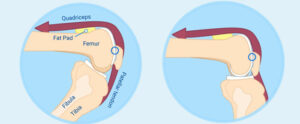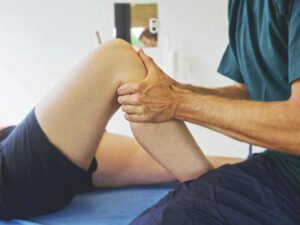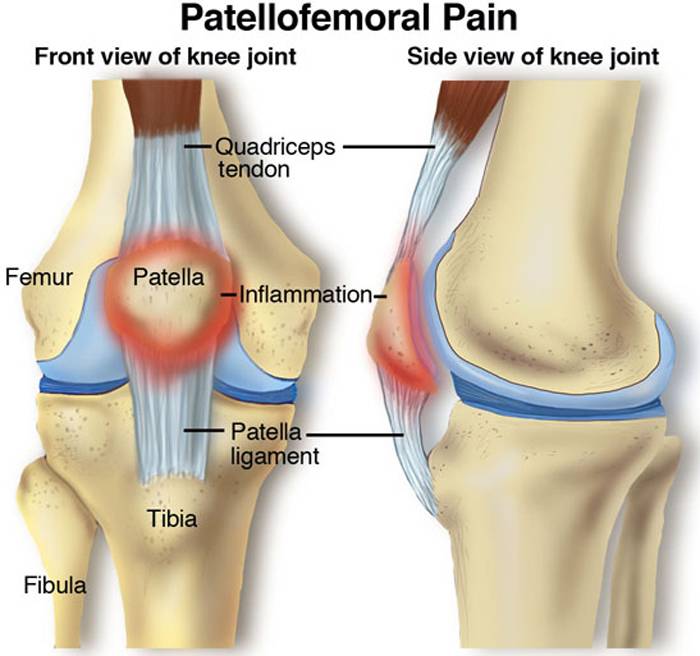Do you experience pain in your knee? It could be patellofemoral pain or PFP. This condition is caused by the improper tracking of the patella (knee cap) and can lead to a wide variety of symptoms. In this blog post, we will discuss the causes, symptoms, and treatment options for PFP. We hope that this information will help you get relief from your knee pain!
Contents
What Is PFP Pain?

Patellofemoral pain (PFP) is a condition that causes pain around the kneecap. The kneecap, or patella, is the bone that protects the knee joint. PFP is also called runner’s knee, jumper’s knee, and anterior knee pain.
PFP is a common injury, especially in people who play sports. It can happen to anyone, but it is more common in young adults and females.
What Causes PFP Pain?
There are various causes of PFP pain. They are included as follows:
- Tight or weak muscles around the knee
- Mechanical problems with the kneecap or patella
- Inflammation of the tissue that lines the kneecap
- Wear and tear on the cartilage under the kneecap
PFP pain can also be caused by overuse. This is common in athletes who participate in sports that involve a lot of jumping or running.
Patellofemoral pain is a type of knee pain that affects the area around the kneecap. The kneecap, or patella, is a small bone at the front of the knee that helps to protect the joint. PFP pain is often caused by overuse, tight muscles, or mechanical problems with the kneecap.
What Are Its Symptoms?
There are various symptoms of PFP pain which are as follows:
1. Pain in the knee while doing activities like going up or down the stairs, squatting, running, or kicking.
2. The pain worsens when you sit for a long time with bent knees, such as when you’re driving or at your desk at work.
3. Popping or cracking sounds coming from your knee.
4. Feeling like your knee is going to give out from under you.
5. Pain that gets worse when it’s cold or humid outside.
If you’re experiencing any of these symptoms, it’s important to see a doctor so they can diagnose the problem and recommend treatment. Left untreated, patellofemoral pain can lead to long-term joint damage.
Complications
There are various complications of PFP pain which are included as follows:
- Anterior knee pain
- Pain with activities
- Swelling around the knee
- Popping or grinding sensations in the knee
- Difficulty bending or straightening the leg
- Weakness in the leg muscles
- Instability of the knee joint
If you experience any of these complications, it is best to see a doctor to get a proper diagnosis and treatment plan.
How It Is Diagnosed?
Your doctor will likely ask about your signs and symptoms and medical history. They may also want to know if you’ve had any previous injuries to your knees or lower legs. To help diagnose patellofemoral pain, your doctor may: Ask you to describe your knee pain, including when it started and what makes it worse.
Do a physical exam: This may involve feeling for tenderness around your kneecap and testing the strength, flexibility, and range of motion of your leg muscles and joints.
Recommend X-rays: These can help rule out other conditions that may be causing your knee pain, such as a fracture or arthritis.
Refer you to a specialist: If your pain is severe or persists despite treatment, you may need to see an orthopedic surgeon or a doctor who specializes in sports medicine.
Treatment Options

There are various treatment options for PFP Pain as follows:
Change in Activities
The first step is to avoid or modify activities that may aggravate the pain. High-impact activities, such as running, can place added stress on the patellofemoral joint and should be avoided or at least reduced. Low-impact activities, such as swimming or biking, can help take the load off the joint and may be recommended as part of the initial treatment.
Weight Management
Excess weight can place added stress on the patellofemoral joint. Losing weight can help reduce pain and improve function. Even a small amount of weight loss can make a difference. For example, a 10-pound weight loss can reduce the load on your knee joint by up to 50 pounds with each step. The best way to lose weight is through a combination of diet and exercise. When you eat fewer calories than you burn, your body will start to use stored fat for energy. This can help you lose weight.
Physical Therapy
A physical therapist can help design a personalized exercise program to stretch and strengthen the muscles around the patellofemoral joint. The therapist may also use other modalities, such as ultrasound or electrical stimulation, to help reduce pain. A physical therapist can also provide guidance on how to modify activities and use proper body mechanics to minimize pain.
In some cases, a physical therapist may also recommend the use of a knee brace or other type of support to help stabilize the patellofemoral joint. Surgery is rarely needed for patellofemoral pain.
Rest and ice
Apply ice to your knee for 20 minutes three to four times a day to help reduce swelling and pain.
Exercise
Strengthening and stretching exercises can help improve your knee’s range of motion and reduce pain. Your doctor or a physical therapist can recommend specific exercises for you.
Orthotics
If foot alignment is a contributing factor to patellofemoral pain, an orthotic device (custom shoe insert) may be recommended to help support the foot in a proper position and off-load pressure from the joint. For instance, an orthotic with medial arch support can help prevent the foot from rolling inward (overpronation). In cases where the big toe points outward and the foot rolls outward (supination), an orthotic with lateral arch support may be recommended.
Wearing an orthotic device may also help to redistribute weight more evenly across the joint and take pressure off the patella (kneecap). Orthotics can be purchased over-the-counter or custom-made by a certified pedorthist. If you opt for a custom orthotic, be sure to have your footwear evaluated as well to ensure that it provides enough room to accommodate the device.
Medications
Anti-inflammatory medications, such as ibuprofen or naproxen, can help reduce pain and swelling. Your doctor may also prescribe a corticosteroid injection to help relieve pastime.It includes medicines like-
1.Ibuprofen (Advil, Motrin)
2. Naproxen (Aleve)
3. Aspirin
Acetaminophen (Tylenol) can also help with pain relief, but it does not reduce inflammation as the other medications do. If over-the-counter medications do not relieve your pain, your doctor may prescribe stronger pain relievers or other types of treatment. Talk To your Doctor
About-Corticosteroid injection, Stronger pain relievers
Your doctor may also recommend physical therapy to help stretch and strengthen the muscles around your knee. A physical therapist can also teach you exercises to help improve your PFP pain.
Surgery
In severe cases that do not respond to conservative treatment, surgery may be recommended to realign the patellofemoral joint or to release the tight tissue around the joint. For instance, a patellar realignment procedure, also called a tibial tubercle transfer, may be performed to move the point where the patellar tendon attaches to the lower leg. This can help reduce stress on the patellofemoral joint and ease the pain. In some cases, the surgeon may also recommend a partial or total knee replacement
Other Treatments
There are other treatments that have been used to treat patellofemoral pain, but there is limited evidence to support their use. These include bracing, taping, and acupuncture. Talk to your doctor about these options and whether they may be right for you.
Conclusion
It may be concluded that PFP pain is a common condition that can be managed with a variety of treatments. While there is no one-size-fits-all approach, a combination of treatments may offer the best results. These may include physical therapy, bracing, injections, and surgery. With proper diagnosis and treatment, most people with PFP pain can find relief.
Always talk to your doctor before beginning any new treatment.
Physical Therapy help patients recover from pain. If you’re experiencing Back pain, Shoulder pain, Knee pain, Neck pain, Elbow pain, Hip pain, or Arthritis pain, a physical therapist at MantraCare can help: Book a physiotherapy session.


